Total Worker Health in Action: December 2014
Volume 3 Number 4 December 2014
Managers’ Buzz
ANITA L. SCHILL, PhD, MPH, MA AND L. CASEY CHOSEWOOD, MD, MPH
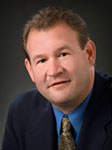
As NIOSH Director Dr. John Howard noted in his stirring keynote address for the 1st International Symposium to Advance Total Worker HealthTM, “Work is one of the characteristics that distinguishes us as human beings, and so work bears a particular mark of our humanity.” He went on to clarify the role of a Total Worker Health (TWH) approach in breaking down the current silos of workforce health and how application of the TWH approach depends on a foundation of adequate health protection.
Dr. Howard’s keynote presentation is available for download ; for more of Dr. Howard’s thoughts on the Symposium, be sure to check out “From the Director’s Desk” in the November 2014 issue of NIOSH e-News.

In follow-up to those insights and the abundance of others shared by eminent researchers and practitioners at our recent Symposium, we are pleased to bring you another issue of our e-newsletter, brimming with coverage of the conference and providing insights into the newest horizons for Total Worker Health.
In this issue of TWHTM in Action!, we are excited to share the story of Alcoa, an organization that has implemented several Promising Practices that align with the NIOSH Essential Elements of Effective Workplace Programs. For a broader perspective on Promising Practices to date, we invite you to peruse the recently released Institute of Medicine report, “Promising and Best Practices in Total Worker HealthTM: Workshop Summary.” This report is based on the May 2014 workshop in Washington, D.C., that featured the perspectives of a wide range of stakeholders, particularly related to their experiences with implementing Total Worker Health programs.
As a stakeholder you have an important opportunity to shape the future of the Total Worker Health field by providing input into the National Total Worker Health Agenda. As evident at the Symposium, the TWH concept draws its richness from the broad range of researchers, practitioners, and employers who are actively working to refine our collective understanding of how to best ensure worker safety, health, and well-being. Please submit your comments to Docket CDC-2014-0014 by December 22.
As always, we hope this newsletter inspires you to become a Total Worker Health advocate. Share your comments and stories about TWH® in Action! with us on Twitter (@NIOSH_TWH), on the NIOSH Total Worker Health® LinkedIn Group, or by email at twh@cdc.gov.

- Managers’ Buzz
- TOTAL WORKER HEALTH™ Exclusive
- Promising Practices for TOTAL WORKER HEALTH™
- Healthier Feds
- Updates from the NIOSH Office for Total Worker Health®
- Updates from NIOSH Centers of Excellence to Promote a Healthier Workforce
- News from our Affiliates and Partners
- New Initiatives and Resources
- Conferences, Webinars, and Trainings
TOTAL WORKER HEALTH® Exclusive
Integrated Safety and Health for Small Businesses
MICHELLE LEE, PUBLIC HEALTH ASSOCIATE, NIOSH OFFICE FOR TOTAL WORKER HEALTH
Depending on your definition of “small,” small businesses comprise between 89.8 and 99.7 percent of employers in the United States (www.sbecouncil.org/about-us/facts-and-data/).
Despite the staggering number of organizations of this size, small businesses are often an underserved population with regard to worksite health promotion efforts or even legally mandated safety practices. Many small business owners say that they simply lack the resources or the time to promote worker safety and health.
With these challenges in mind, a recent NIOSH Total Worker HealthTM Webinar united complementary efforts of one of the original NIOSH-fundedCenters of Excellence to Promote a Healthier Workforce and a new NIOSH Total Worker Health Affiliate to delve into the issue of integrated interventions for smaller businesses.
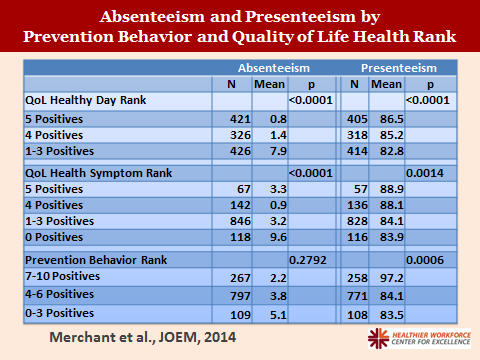
Slide courtesy of James A. Merchant. In a survey of 1602 Iowan voters, employed respondents who reported experiencing high quality of life and frequent health preventative behaviors also reported incrementally fewer days missed from work due to sickness (“Absenteeism”) and higher levels of self-rated overall job performance (“Presenteeism”).
Dr. James Merchant, founding dean of the Iowa School of Public Health and director of the Iowa Healthier Workforce Center for Excellence (HWCE), led the charge with recent research on quality of life, prevention behaviors, and productivity by employment status in Iowa. The study he presented is part of a larger effort by HWCE to provide small employers (who constitute the vast majority of employers in Iowa) with information and low-cost tools to assist them in promoting a healthier workforce.
The research findings establish a baseline for understanding the distinct health challenges and positives faced by groups with diverse employment situations, and provide a strong data-driven rationale for worksite safety and health programs. His research confirms that quality of life and strong prevention behaviors do in fact correlate with less sickness-absenteeism and higher productivity.
Dr. Lee Newman, director of the Center for Worker Health and Environment within the Colorado School of Public Health, followed up with a more practice-based perspective on the challenges facing small businesses, drawing on his work with small to medium-sized enterprises through Colorado-based nonprofit Health LinksTM.
Dr. Newman discussed some of the primary barriers to adoption of programs for worker safety and well-being, which include information overload, uncertain return on investment (ROI), and lack of management support. Potential strategies to address these barriers, however, included promoting the idea of “value on investment” (VOI) rather than ROI, as well as providing simplified programs to begin with and leveraging the power of local partnerships. He advocated for taking advantage of what already exists in an organization; if either safety or wellness is already robust, then building on that strength can be fruitful. However, if neither safety nor health promotion is in place, then both can be integrated from the beginning. Dr. Newman asserted that wellness programs can be a “Trojan Horse” for safety—an avenue through which existing occupational safety and health practices can be bolstered.
Both presenters emphasized the need for expanded research and practice programs to engage small employers and their stakeholders. To view the presentation and learn about other webinars, please visit the NIOSH Total Worker Health Webinar Series page.
Promising Practices for Total Worker Health®
In Promising Practices for Total Worker Health® we share how employers from across the country and a range of industries are taking steps to effectively integrate both health promotion and health protection in their workplaces.
If your organization is proactively integrating health protection and health promotion to prevent injury and illness and advance the well-being of your workers, please email us at twh@cdc.gov.
Disclaimer: The mention of organizations and commercial entities and products in this article is for illustrative purposes only and does not represent an endorsement by NIOSH, CDC, or the U.S. Department of Health and Human Services.
Innovating an Integrated Path Forward at Alcoa
CHIA-CHIA CHANG, COORDINATOR FOR STRATEGIC PARTNERSHIP AND NEW OPPORTUNITY DEVELOPMENT, NIOSH OFFICE FOR TOTAL WORKER HEALTH
Alcoa, a global leader in lightweight metals technology, engineering, and manufacturing, is making strides in integrating health protection and health promotion. It is incorporating NIOSH’s Essential Elements (Essential Elements of Effective Workplace Programs and Policies for Improving Worker Health and Wellbeing) into several of its initiatives.
Organizational Culture and Leadership
The integration effort can be seen in the structure of Alcoa, which employs more than 60,000 in over 200 locations worldwide. The company is organized into three segments: Engineered Products and Solutions (EPS), Global Rolled Products (GRP), and Global Primary Products (GPP). Each segment comprises business units. Leaders at the segment and business unit levels direct safety, health, and wellness activities within their businesses. Demonstrating leadership is one of the Essential Elements Alcoa has used to advance its initiatives. The Environment, Health, Safety and Sustainability (EHS) Resource Unit is now responsible for safety, occupational health, and employee wellness, which had previously been administered by the Benefits unit.
Alcoa’s vision is guided by a set of organizational values that were refreshed in 2012 to include employee wellness in the Environmental, Health & Safety Value. Alcoa created the position of Director of Global Wellness to lead its global initiative and implement best practices for reducing health risks, improving overall health, and working with the existing safety infrastructure to prevent risks and hazards.
Program Design

Photo source: Alcoa
Another Essential Element is integrating systems. An example at Alcoa is the fatigue risk management group, which is led by a cross-functional team that includes the Vice President of EHS for GPP, the Alcoa Occupational Medicine Physician, the Director of Global Wellness, and other environmental and industrial specialists across Alcoa’s businesses.
The fatigue risk management group provides education and resources that help employees manage their risk for fatigue. It also makes recommendations to help Alcoa keep the work environment safe and minimize the impact of fatigue; these have resulted in global guidelines on appropriate shift work and overtime for the protection of workers and a permit process including employee input on deviations to the guidelines. Some businesses have implemented special actions specific to their needs, such as additional rest breaks and facilities to address fatigue.
Program Implementation and Resources
Alcoa strives to provide adequate resources and communicate strategically. The wellness champion, who leads wellness efforts at a single worksite and oversees the location’s Wellness Committee, is often an industrial hygienist or safety specialist. Each champion receives training and education on how to form a strong committee with labor representation. Health education includes relevant work-related issues, such as OSHA Hazard Communication training, hearing conservation, and wellness initiatives. Training is delivered in toolbox sessions, in formal meetings, and online.
Program Evaluation
Alcoa actively engages in activities to measure and analyze. It conducts surveys at the corporate level and at individual sites to assess whether workers believe they have benefited from company-sponsored programs and events. The Alcoa internal homepage prominently features real-time safety metrics, including rates of near-misses and injuries, split by business segment and compared to the previous year’s metrics. To track progress in helping employees improve their health, the wellness champion at every location receives data that include participation rates, aggregate health condition status, and healthcare costs, and is encouraged to share the aggregate data with the workers on site. Using the data it gathers, Alcoa will continue to enhance its safety, health, and wellness initiatives by assessing current conditions and setting new targets.
By leveraging several NIOSH Essential Elements of effective workplace programs and policies, Alcoa is able to advance its steady commitment to protecting employees, contractors, customers, and the communities in which it operates.
Healthier Feds
A growing body of scientific evidence indicates that the quality of the work environment is a predictor of individual health behaviors. In support of this notion, the federal government is providing opportunities for advanced health and well-being in its own workforce. The purpose of this section is to spotlight ways in which the federal community is improving the health and safety of federal employees.
Healthier Federal Workers 2014 Conference Recap
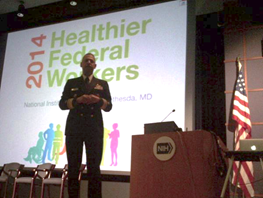
The U.S. Surgeon General, RADM Boris Lushniak, opened the Healthier Federal Workers 2014 conference with a motivational message: "When we become a healthier nation, we become a better nation!" Image source: US Surgeon General Twitter account (@Surgeon_General) posted on October 8.
The third of its kind, the Healthier Federal Workers 2014 Conference (HFW2014) was held October 8–10 at the National Institutes of Health’s Natcher Center in Bethesda, MD. The conference was sponsored by NIOSH, U.S. Department of Health and Human Services, CDC, NIH, U.S. Office of Personnel Management, U.S. Department of Veterans Affairs, Federal Occupational Health, and the U.S. Department of the Army. Participants shared health and well-being practices across the federal government.
The U.S. Surgeon General, RADM Boris Lushniak (pictured right), opened the meeting with a motivational message: “When we become a healthier nation, we become a better nation!” This was followed by a set of push-ups with the keynote speaker, mc schraefel (lowercase deliberate), of the University of Southampton, UK. Her message focused on the importance of the mind-body connection in our work. She illustrated that importance of the human interface in the design of work so it supports and encourages creativity, innovation, meaning, and overall quality of life.

m.c. schraefel, keynote speaker at HFW2014, delivering an impromptu self-interview on evils of sedentarism. Image source: m.c. schraefel Twitter account (https://twitter.com/mcphoo) posted on October 17.
The conference was packed with information that touched on all facets of being healthy. Fitness-casual attire was encouraged so that participants could take part in health and well-being breaks throughout the conference. Attendees also had engaged in Chef-led discussion on healthier food services within Federal agencies.
The conference concluded Friday, October 10 with workshop opportunities.
We hope that you will join us at the next conference, and until then….live well!
CDC Becomes the First Federal Agency to Achieve HealthLead® Certification!
Adapted from CDC Connects
Congratulations to the Centers for Disease Control and Prevention (CDC) on achieving the Bronze Level of HealthLead accreditation. CDC is the first federal agency to achieve this award and joins the ranks of over 20 companies that are accredited.
HealthLead® (http://www.ushealthlead.org/about-healthlead) gives CDC’s WorkLife Wellness Office and partners accreditation and recognition for promoting the health and well-being of CDC staffers where they live, learn, work, and play. This team fulfilled HealthLead certification requirements and a site visit with HealthLead staff. The external accreditation body has identified clear standards in three important areas: organizational engagement and alignment, population health management and well-being, and outcomes reporting.
The NIOSH Office for Total Worker HealthTM is one of many partners in this endeavor.
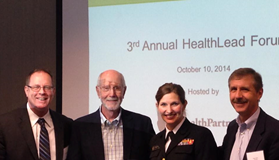
CDC and HealthLead officials meet to celebrate organizational commitment to healthier work.
Updates from the NIOSH Office for Total Worker Health®
Open for Public Comment: Proposed National Total Worker Health Agenda
The NIOSH Office for Total Worker Health® has proposed a National Occupational Research Agenda (NORA) meant to stimulate innovative research, practical applications, policy guidance, and capacity-building of health protection and health promotion practitioners across the nation. We invite you to provide input on the top-priority research, practice, and policy issues to include in the proposed National Total Worker HealthTM Agenda to help improve integrated workplace practices, prevent worker injury and illness, and advance worker safety, health, and well-being. The draft agenda is available for public comment, until closing of the federal docket on December 22, 2014, 11:59 pm EST.
The NIOSH Office for Total Worker Health encourages all comments and specifically seeks to address the following questions:
- Do you see your own organization’s goals reflected in the Proposed National Total Worker Health Agenda?
- What are the bridges between your own work and the Proposed National Total Worker Health Agenda?
- Are there any missing components or gaps in the Proposed National Total Worker Health Agenda?
To view the draft National Total Worker Health Agenda and to learn more, visit www.cdc.gov/niosh/docket and search for NIOSH Docket 275.
Official written comments, identified with CDC-2014-0014 and docket number NIOSH-275, may be submitted by any of the following methods by 11:59 p.m. EST on December 22, 2014.
- Internet via Federal Rulemaking Portal: All submissions received must include the agency name and docket number. All relevant comments, including any personal information provided, will be posted without change to http://www.regulations.gov.
-
Mail: National Institute for Occupational Safety and Health
NIOSH Docket Office
1090 Tusculum Avenue, MS C-34
Cincinnati, OH 45226-1998
Need a little inspiration? Read the recently released report from the Institute of Medicine: Promising the Best Practices in Total Worker Health (TM): Workshop Summary.
Highlights from the 1st International Symposium to Advance Total Worker Health
The 1st International Symposium to Advance Total Worker Health proved to be an immersive 2½ days of cutting-edge scientific and practical sessions, bookended by engaging workshops. A second conference tailored toward federal workers, Healthier Feds, rounded out the week. (For more on Healthier Feds 2014, see this issue’s Healthier Federal Workers)
The Symposium attracted over 350 attendees from a broad spectrum of fields, including occupational safety and ergonomics, worksite health promotion, occupational medicine, academia, and human resources. Sessions shed light on various aspects of Total Worker Health (TWH) approaches, including the health and safety challenges and opportunities in industry and worker populations, methodological challenges and innovations related to TWH interventions, new theories to guide future scientific inquiry in the field, common barriers and strategies to implementing integrated interventions. Researchers and practitioners were able to network, learn from each other, and create new connections to inform their current and future work.
Each of the NIOSH-funded Centers of Excellence for a Healthier Workforce served as a presenting partner, thus contributing to the overall planning and selection of the meeting sessions, and keynote panel discussions. Below are some highlights from each of the four Centers of Excellence.
The Center for the Promotion of Health in the New England Workplace (CPH-NEW) hosted 7 presentations, 7 posters and a pre-symposium workshop. Co-Directors, Drs. Martin Cherniack and Laura Punnett, discussed the challenges of implementing TWH in practice and the future workforce development to support TWH. Additional themes throughout CPH-NEW presentations included the health and safety of correctional officers and the nursing home workforce.
Glorian Sorensen, PhD, Principal Investigator of The Harvard Center of Work, Health, and Well-being, participated in the opening plenary session with directors of the three other NIOSH-supported TWH Centers of Excellence. Twenty-five presentations and workshops were conducted by Center investigators, collaborators, and post-doctoral fellows. Center sessions were well attended, and there was much interest in the Center’s conceptual model, SafeWell Guidelines (#safewell), assessment tools for worksite walk-throughs, and the Indicators of Integration tool.
Researchers from the University of Iowa Healthier Workforce Center for Excellence (HWCE) contributed to several sessions:
- James A. Merchant, MD, DrPH, Director of the Iowa HWCE, served as panelist during an opening platform session on “Research Frontiers in Total Worker Health®: Unique Perspectives from the NIOSH TWH Centers for Excellence.”
- Diane S. Rohlman, PhD, Associate Director, presented “Promoting Adoption of Total Worker Health®: Lessons Learned from Small Businesses.”
- Jennifer L. Hall, EdD, MCHES, Associate Director for Outreach, presented “Analyzing Online Engagement Levels for Advancing Total Worker Health Outreach and Communication Efforts.”
- Cassidy Branch, MA, ATC, LAT, Research Associate, presented “A Worksite Wellness Coaching Component of a Total Worker Health Intervention in a Manufacturing Setting.”
- Mark Schall, MSE, Graduate Research Assistant, and Nathan B. Fethke, PhD, CPE, Deputy Director, presented “Digital Human Modeling of Non-Occupational Risk Factors for Manufacturing Work Task Design.”
- Sandra Ramey, RN, PhD, Research Pilot Project Principal Investigator, presented “Evaluating Stress Resilience: A Worksite Intervention to Reduce Stress and CVD Risk Factors in Police.”
Oregon Healthy Workforce Center (OHWC) members made 12 presentations at the Symposium, including one on the effectiveness of team- based interventions for improving both safety and wellness. This series of presentations will be repeated, with more comprehensive analyses, at the Governor’s Occupational Safety and Health conference on March 9–12, 2015, at Portland’s Oregon Convention Center.
Even if you were unable to attend the Symposium, there are ample opportunities to learn about the proceedings and contribute to the conversation around Total Worker Health. We are happy to announce that select presentations from the 1st International Symposium to Advance Total Worker HealthTM are now online, and can be accessed at: http://www.eagleson.org/conferences/total-worker-health/twh2014-presentation. Also, be sure to read Dr. Howard’s perspective of the meeting in the Directors’ Desk in the recent issue of NIOSH e-News, and stay tuned for the new series of Total Worker Health–themed blog posts on the NIOSH Science Blog.
Updates from NIOSH Centers of Excellence to Promote a Healthier Workforce
University of Iowa Healthier Workforce Center for Excellence (HWCE)
The HWCE is pleased to announce a new, more user-friendly website with easier-to-find resources for planning, implementing, and evaluating integrated workplace safety and wellness programs and studies. Links are highlighted below.
- For the Workplace: Portal for employers to learn the what, why, and how of the Total Worker Health approach and access resources for implementing integrated and comprehensive workplace programs.
- Program Support: Portal to assist employers with delivering workplace health, safety, and wellness topics relevant to TWH.
- For the Researcher: Portal for researchers to learn more about HWCE research projects and funding opportunities and to access publications, technical reports, and presentations related to Total Worker Health.
Oregon Healthy Workforce Center
The Oregon Healthy Workforce Center (OHWC) along with the Oregon Institute of Occupational Health Sciences and Portland State University sponsored a full-day symposium on Healthy Workplace Solutions: From Research to Practice on November 7 in Portland. All OHWC symposia are also available by live webinar. Visit the symposium website to view the full program. For other resources addressing health, safety and wellness, visit our online library.
The OHWC is recruiting for a center manager with an advanced degree in applied psychology or a related field, and the Oregon Institute of Occupational Health Sciences is recruiting for two faculty members specializing in behavior change in areas of basic and applied science. Apply at http://www.ohsu.edu/xd/about/services/human-resources/.
The Center for the Promotion of Health in the New England Workplace (CPH- NEW)
Corrections Research Takes National Stage
Correctional officers are at high risk for suicide, depression, obesity, hypertension, and early death due to chronic disease. According to Dr. Martin Cherniack, CPH-NEW co-director, serious health issues sometimes develop soon after such workers are hired. CPH-NEW and the Oregon Healthy Workforce Center convened a National Symposium for Corrections Worker Health in July to focus the national research spotlight on the needs of this high-risk workforce. Read more.
Recently published by CPH-NEW are two peer-reviewed publications and two CPH News and Views emerging issue briefs:
- Musculoskeletal disorder symptoms in correction officers: Why do they increase rapidly with job tenure?
- Promoting integrated approaches to reducing health inequities among low-income workers: Applying a social ecological framework
- Issue #38: Will treadmill workstations be used by office workers?
- Issue #39: Use of financial incentives in workplace weight-loss programs
Harvard Center for Work, Health, and Well-being
A recent article on work stress, sleep deficiency, and cardiometabolic risk in patient care workers has created scientific and media interest in the United States and Norway. Analyses showed that among nurses with work stress and sleep deficiency, healthy sleep and exercise patterns are important for modifying risk for heart disease. The publication is also featured in a recent NIOSH Science Blog titled Work-family Conflict, Sleep, and the Heart. The reference is Jacobsen HB, Reme SE, Sembajwe G, Hopcia K, Stiles TC, Sorensen G, Porter JH, Marino M, Buxton OM [2014]. Work stress, sleep deficiency, and predicted 10-year cardiometabolic risk in a female patient care worker population. Am J Ind Med 57(8; August):940–949.
News from our Affiliates and Partners
Four New NIOSH TWH Affiliates
The NIOSH TWH Affiliate Program has four new affiliates, including, most recently, a new Clinical Center of Excellence Affiliate, the prestigious Mt. Sinai Health System.
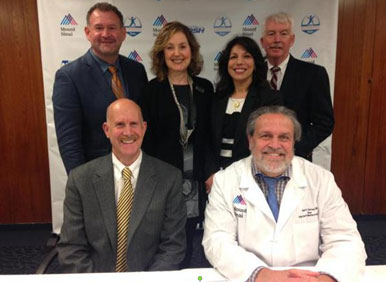
NIOSH and Mt. Sinai officials on day of signing of the Memorandum of Understanding. Image source: Mount Sinai Hospital Twitter account
The Mount Sinai Health System, explores strategies that integrate health protection and health promotion activities for its 36,000 employees. As TWH Clinical Centers of Excellence, the Mount Sinai Selikoff Centers for Occupational Health, the health care delivery cores for the Department of Preventive Medicine within the Icahn School of Medicine at Mount Sinai, will offer health promotion services to patients and collaborate with employers and organizations to develop comprehensive workplace health and safety programs. The Department of Preventive Medicine will spearhead research initiatives to evaluate the effectiveness of TWH interventions and train future health care professionals on integrated TWH strategies in general preventive medicine and occupational and environmental medicine through its residency training programs.
The Kentucky Department for Public Health, through the Worksite Wellness Initiative, the Kentucky Safety and Prevention Alignment Network, and the Kentucky Injury Prevention and Research Center, is developing a partnership that will establish and promote Total Worker Health in Kentucky. This partnership will serve as a catalyst in the formation of a state-level steering committee of private and public organizations, to provide leadership in the development of a whole-person safety and health model for employers and a public awareness campaign for TWH in Kentucky.
The mission of the Kentucky Injury Prevention and Research Center (KIPRC) as a NIOSH TWH Affiliate is to join worker safety and health with community safety and health promotion through collaborations with public and not- for-profit organizations. KIPRC envisions Total Worker Health in Kentucky as a holistic and empowering strategy to meld worker well-being with injury and illness prevention in local businesses and communities. Within KIPRC, a number of programs and activities support the TWH mission, such as the National Center for Injury Prevention and Control–funded state violence and injury prevention program, Kentucky Safety and Prevention Alignment Network (KSPAN), the NIOSH-funded Kentucky Fatality Assessment and Control Evaluation and Kentucky Occupational Safety and Health Surveillance programs, National Safety Council–funded Safe Communities Kentucky program, and Kentucky Department for Public Health–funded Community Injury Prevention Program.
The fourth recently signed NIOSH TWH Affiliate is the National Safety Council (NSC), a nonprofit organization whose mission is to save lives by preventing injuries and death at work, in homes and communities, and on the road through leadership, research, education, and advocacy. NSC advances this mission by partnering with businesses, government agencies, and the public to make an impact where the most preventable injuries and deaths occur.
Participation in the Affiliate Program is voluntary and intended for academic institutions, labor organizations, public sector entities, and nonprofit associations that align with the principles of a Total Worker Health approach. If your organization is interested in becoming a NIOSH TWH Affiliate, please visit the NIOSH Total Worker Health website at /niosh/twh/affiliate.html or contact the NIOSH Office for Total Worker Health via email at twh@cdc.gov.
New Initiatives and Resources
Got eNews? Get NIOSH News in Your Inbox Today
Get updates on the newest NIOSH research, products, and events straight to your inbox by signing up for NIOSH eNews. This electronic newsletter will arrive monthly and includes a message from our director, Dr. John Howard, and features on topics such as new NIOSH communication products, NIOSH in the news, upcoming conferences, and more. To see previous issues of eNews or to subscribe, go to /niosh/enews/default.html.
Conferences, Webinars and Trainings
HSPH Executive Continuing and Professional Education Course: Work, Health, and Well-being: Integrating Wellness and Occupational Health and Safety in the Workplace, on January 26–29, 2015, in Boston, MA. This applied program provides the knowledge necessary to integrate health promotion and health protection programs to enhance worker health, minimize work-related injuries and illnesses, and reduce health care–related costs. The course is ideal for professionals with direct responsibility for the health, safety, and well-being of employees as well as those who are designing or directing health protection and health promotion programs. Participants will represent diverse sectors, industries, and job functions and will come from around the world.
Cardiovascular Health and Disease: Occupational and Environmental Factors and Updates in Occupational and Environmental Medicine, on March 12–14, 2015, in San Francisco, CA. This course, presented by the Division of Occupational and Environmental Medicine in the Department of Medicine at the University of California, San Francisco, provides occupational and environmental health professionals and persons from other health-related disciplines with a review and update of current data in occupational and environmental medicine.
The Eleventh International Conference on Occupational Stress and Health, “Work, Stress, and Health 2015: Sustainable Work, Sustainable Health, Sustainable Organizations,” will be held at the Westin Peachtree Plaza on May 6–9, 2015, with preconference workshops and opening events on May 6. To learn more, visit http://www.apa.org/wsh.
We would love to hear from you! Please send your comments and suggestions to us at twh@cdc.gov
This newsletter is published quarterly via email by the National Institute for Occupational Safety and Health Office for Total Worker Health Coordination and Research Support to inform members of the public health community as well as interested members of the general public of program-related news, new publications, and updates on existing activities and initiatives.
